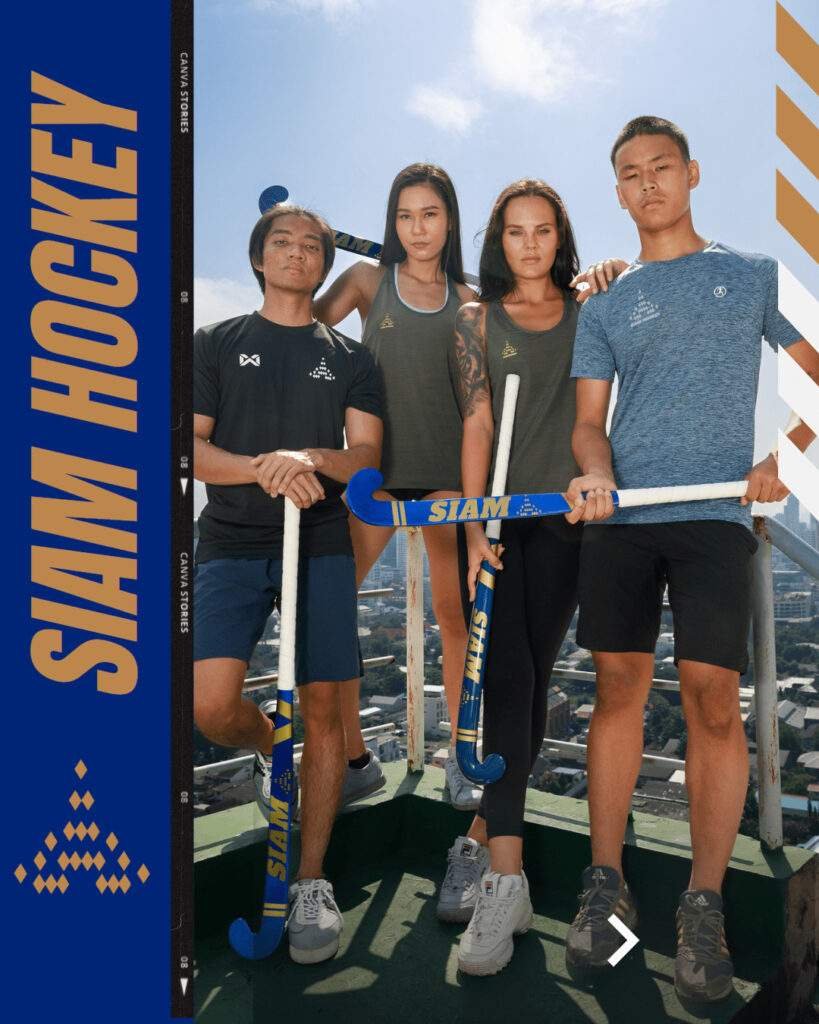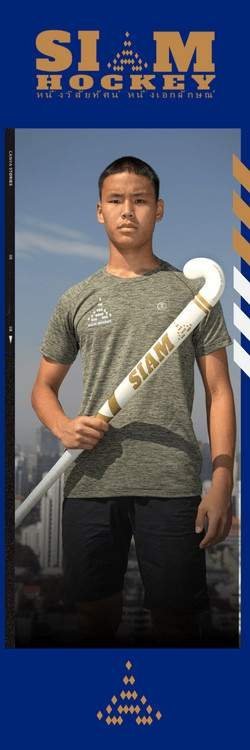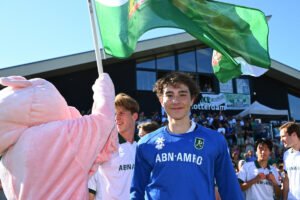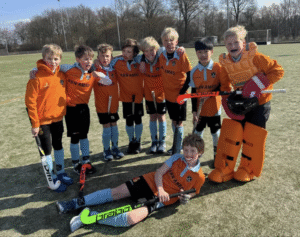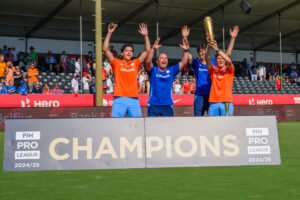They wrote field hockey history exactly ten years ago. Were featured on Studio Sport as indoor field hockey internationals because they became the first Dutch men’s team to win the indoor World Cup. With striker Robbert van de Peppel, captain Robert Tigges and goalie Laurens Goedegebuure, three heroes of the time, we look back on that indoor miracle in two parts. Today part 1: the road to Leipzig.
‘Do you see Mirco Pruyser here, with his short spiky hair? He looks like a young Michael van Gerwen!’
The three World Cup winners burst out laughing. One old team photo after another is conjured up in the main hall of Almere’s Topsportcentrum. They have brought along some indoor gear on request. Medals, shirts and old articles. ‘What an incredibly ugly thing it actually is,’ Goedegebuure says of his gold plaque. ‘They put a sticker on it from the tournament. As if they had forgotten the real medal. I showed it to my kids yesterday and they were almost disappointed. “Dad, is this what you get?”
Van de Peppel: “Not normal. Like it came from the carnival. I had to look for my medal. It was in the bin with all the prizes belonging to Laurien (his wife, former international Leurink, ed.). She has about fifty of them. I have twelve or so, including the prizes with Laren Boys D1.’

From left to right: Van de Peppel. Goedegebuure and Tigges with an old article about their indoor success in their hands. Photo: Willem Vernes
Tigges, meanwhile, is holding a shirt. ‘That was mega-tight. Far too fitted, with a very irritating elastic band at the bottom. During the World Cup I was just over thirty. I carefully started to develop a small paunch. It popped out at one point when I pushed a corner. I’m afraid there’s a photo of that too. It was really no sight.’
Goedegebuure: ‘My goalkeeper’s shirt was just much, much too big. I didn’t fit it then. Now it does, haha.’
We did a lot of booing here. The tradition is that the loser gets an assignment. As a result, it regularly happened that someone walked across the stands with a beam on his back between two training sessions Robert Tigges
We brought the world champions together in a logical and, for them, nostalgic place. Almere was the regular training location of the Dutch indoor team. ‘We really know every nook and cranny of this venue,’ Tigges states.
‘When you arrived here, it was always a question of whether the hall was open. If you were early, you were standing outside freezing. Coffee wasn’t available until intermission.’ He points to the corners of the hall: ‘That’s where we hung behind the curtains to look for balls. And we did a lot of topping here. You know, that card game. The tradition is that the loser gets an assignment. So because of that, it regularly happened that someone walked across the bleachers with a beam on his back between practices. I can remember that happening to Teun Rohof And Max Sweering.

Tigges pushes a corner in the disheveled, fitted shirt. Photo: Koen Suyk
Indoor training with field sticks
Every winter they returned to Almere, where the bars were laid as early as eight in the morning. There the foundation was formed for later indoor success. But the road to it was pretty bumpy. The new Dutch indoor era began with the appointment of national coach Robin Rösch at the end of 2006. A German with indoor field hockey in his blood. ‘Until that moment there was hardly any continuity,’ says Tigges.
‘Internationally, we had been relegated to the B group. You could join the selection if you came from the young national team and had time. That also applied to me. I had an indoor stick, because we played pretty serious indoor hockey at Rotterdam. But there were also guys who stood in the hall with their field stick or had to borrow an indoor stick.’

The stickered gold medal. Photo: Willem Vernes
Laughing hard: ‘Boys, you know the story of the first practice under Robin, right? Back then there weren’t even hall balls. Those heavy kookaburra balls came out of the bag in the Olympos hall in Utrecht. Some of our boys started dragging them around. Didn’t make any sense at all. From then on, things could only get better. Fortunately, with Robin, things got more serious. Guys came on the team who really could and wanted to play indoor hockey. It remained part of the training towards the Orange, but it became less non-committal.’
That soon brought success. In the first tournament under Rösch – the 2008 European Championship in Copenhagen – the indoor men immediately promoted to the highest group. A special prize, because the next European Championships -of 2010- were held in Almere. ‘So here,’ Van de Peppel underlines again, looking at the field. Like Tigges, the striker was already there in Copenhagen. ‘There were a hundred people in the stands, if you were lucky. That was different in Almere. It was completely full here, a few thousand people. If you scored here, you suddenly felt like a hero as an indoor player. We had never experienced that before. And then we came in third. Also to our own surprise. For the first time I had the idea that indoor field hockey was alive’.

The bronze team at the 2010 European Championship in Almere. Photo: Frank Reelick
Goedegebuure: ‘I was already training in that period. But didn’t play a tournament yet. I went to watch some matches. It was in the middle of nowhere, but it was awesome. I wanted this too, although for me it was a stepping stone to stay in the picture for the Dutch field team after the Dutch national team. But I also noticed that it was a tight, nice group. Guys who didn’t see it as an afterthought, but were already looking forward to going back into the hall in September.’
A year after Almere’s indoor boost came the World Cup in Poznan, where the Netherlands finished fifth. Goedegebuure: ‘That was fine for then. I remember that we sat together with a group after that, with Robin. All three of us were there. Rohof too. The intention was to keep that core together and to add to it. Going to Germany more often on training camp, where of course the best indoor field hockey was played.’ Tigges: ‘We also had more and more to look for there. In those early days we lost 11-2 to a team from the Second Bundesliga. Three years later we played a draw against Rot-Weiss Köln, then the best team in Germany.’
A daily allowance of forty euros
Van de Peppel: ‘During that World Cup in Poland we came close to top countries like Germany and Austria for the first time, although we still couldn’t keep up for the whole match.’ Laughing: ‘But then we totally didn’t expect that we would ever become world champions.’
Tigges: ‘We got paid. In our way. There was a daily allowance. That was something like forty euros. Plus a mileage allowance and a sandwich. So yes, it was charity. But it doesn’t feel like we had to leave much in one piece. We had so much fun. Were standing here early in the morning running against each other. Champions League sprints we called it. As hard as you can. We also had Eredivisie sprints, when it had to be less fast.’ ‘I was in the Keuken Kampioen Divisie by then,’ Goedegebuure laughs.

Van de Peppel at the 2011 World Indoor Championships in Poznan. Photo: Frank Uijlenbroek
No Jeroen Hertzberger, but Lars Balk.
Tigges: ‘As an indoor player it is always a struggle. Every year you get the familiar questions: why do you do this? Why do you put so much time into it?’ Van de Peppel: ‘Because we all thought it was fokking beautiful. We built something together. Of course, it also helped that Robin ended up coaching for almost ten years. It is difficult to move forward if you always have someone else in front of the group.’
After Poznan, the European Championships of Leipzig (4th) and Vienna (5th) followed. The Orangemen had become a fixture in the sub-top, but still did not really make it difficult for the established order. ‘Besides that solid core, it was always changing who we could bring,’ Tigges said. ‘Field internationals like Marcel Balkestein and Jeroen Hertzberger wanted to participate in a tournament, but couldn’t because they had to go on a training trip to South Africa with their national team. Every winter it was a question of which pond we could fish in. At the World Cup we won, we were allowed to bring Lars Balk and Bjorn Kellerman, for example, who were already competing against the big Oranje at the time. That does make a big difference.
Olympic champion Balk and European Championship winner Kellerman later created furor on the field with the Orange. ‘But for the three of us this was the highest stage,’ Goedegebuure concludes. This was our Dutch team. This is how we experienced it. We did everything we could. It was insane. Even without media attention.’
But so that attention changed in 2015, in Leipzig. More about that in the second part of this retrospective.
by Hockey.nl

